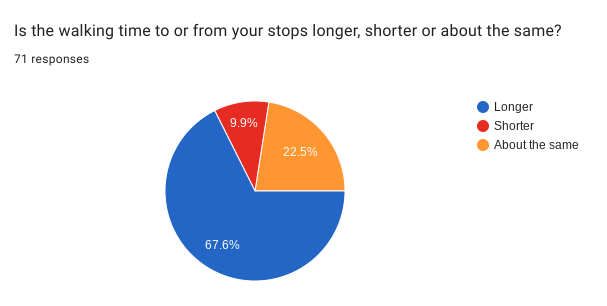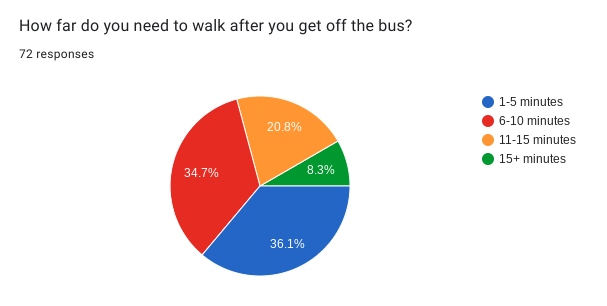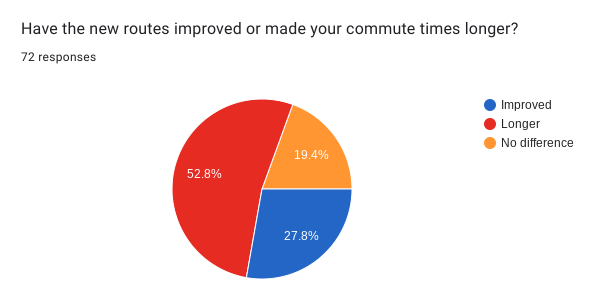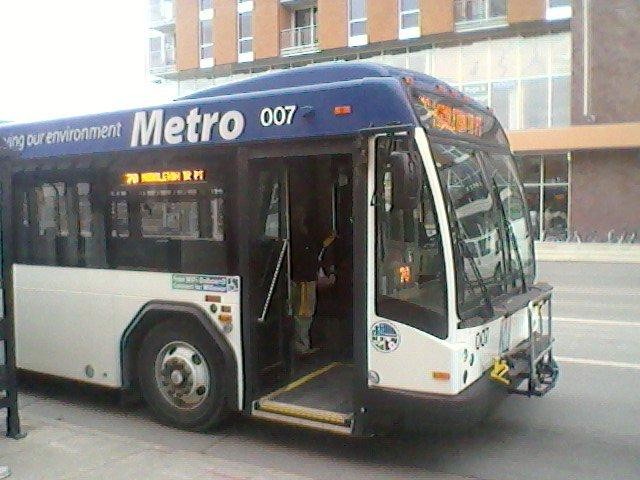We’re revisiting some of our favorite stories of the year. This one was first published on August 8 on Blueprint365.org.
 We all have feelings about the buses before and after the revamp. Some are good and some are not, but it’s important to remember that the revamp has left a lot of people behind and that hasn’t been adequately addressed yet as Metro still works on more projects without rectifying the problem it caused.
We all have feelings about the buses before and after the revamp. Some are good and some are not, but it’s important to remember that the revamp has left a lot of people behind and that hasn’t been adequately addressed yet as Metro still works on more projects without rectifying the problem it caused.
— Omar Waheed
The road to hell is paved with good intentions, as the saying goes, but those roads are now harder to get to for some, as those with mobility issues face new challenges navigating revamped Madison Metro routes.
On June 11, Madison Metro launched a redesign of its service with new routes, stops and an attempt at simplifying its naming system. The goal was to simplify riding and reduce commute times. Most riders indicate that the new routes are good — or at least the intention behind the Madison Metro redesign is — but getting to the bus is now an issue that many reliant on public transportation are struggling with now more than ever.
In the week preceding the revamp, Madison365 attended multiple community information meetings with Madison Metro. In the meetings, Metro said that the new routes will not be a one-for-one exchange and that some people will be negatively affected by the changes. Community members showed concern about accessibility for those with mobility impairments. Metro’s hard stance in the meetings was that those with accessibility issues could use its paratransit service instead.
But Blueprint365 found that paratransit is more expensive and difficult to access than regular Madison Metro buses.
To get a better picture of the issue, Madison365 sent out a survey about experiences with the new routes and stops. Over 70 answered the survey. Of those, just over half said their commute times are now longer, while 28 percent said their commute time was shorter, and 19 percent said there was no difference. The largest group – about 40 percent – said they have to walk five minutes or less to get to a bus stop, but more than two-thirds of respondents said their walking time to or from their bus stops is longer now than it was before the redesign.




Of those who responded, 23 were willing to follow up with a Blueprint365 reporter. Of the 23 willing to follow up, seven responded to interview requests and had concerns about the routes. Five respondents of the seven who were willing to follow up had new issues regarding mobility impairments getting to the bus and their intended destinations.
Joan Downs is 71 years old and walks with a cane. Previously the bus stopped in front of her home where she would walk, what she estimates, 500 feet to get to the bus. She now has to walk between three-tenths and half a mile to even board the bus.
“In particular those who need it most, the elderly and disabled… Public transportation is a service that should help the public as much as possible. Not just the people who have to go to work and back,” said Downs. “If you don’t have a car, if you don’t have family or friends who can pick you up at their disposal, you’re out of luck.”
She has been finding difficulties getting to her appointments and shopping around the Atwood neighborhood. Her therapist moved offices to Atwood recently where the bus does not make a stop. She does not see the new routes as sustainable for her with her condition. Downs has been left with no other choice but to take paratransit to attend her medical appointments and pick up her medication. She is currently in the application process for the service, which can take several weeks to be approved.
Downs is not alone. Debra White, 62, has been in Madison for the past 38 years. She has arthritis that affects her ability to get around. She relied on the bus to take her to medical appointments and Walgreens on Whitney Way for her medication. The new routes and stops makes her unable to get to where she needs to go without having to walk a considerably longer distance.
“I think the Madison Metro bus system sucks. The crazy part about that is that most of the bus drivers I encountered had no idea how to help… passengers. They had no knowledge or no information on how to navigate the new bus system,” said White. “It’s sad for people who have wheelchairs and walkers. It’s ridiculous.”
White had never heard of paratransit before her interview with Blueprint365. The changes to the routes were mostly a surprise to her after she saw signs saying that her bus stop would no longer be where it had been on Madison’s west side. After learning about the paratransit service in an interview, she was confused as to how she was supposed to afford the alternative on a fixed income.
Paratransit, the alternative service being pushed by Metro for those with disabilities, costs more than the bus. The cost per ride on paratransit is $3.25; riders must pay exact fare or pre-order a booklet of six tickets for $19.50.
Normal fare for the bus ranges from $2.00 an adult to ride or $32.50 for a 31-day pass for senior or disabled passengers. White is unsure how she would be able to afford the service.
Additionally, paratransit requires riders to book a ride at least 45 minutes in advance. Madison Metro has said It is not a service for quickly grabbing medications. Scheduling for rides requires an advanced booking and the application process takes a minimum of 21 days with an assessment to determine if a rider is suitable for paratransit. It is not a viable alternative for short trips, Madison Metro officials said in community meetings. Hours are between 5:15 am-11:30 pm Monday through Friday and 6:15 am-11:00 pm on weekends.
It’s not just the elderly that feel left behind. Bri C., who did not wish to have their full name published due to personal safety issues, suffers from tendonitis. Bri is occasionally bound to crutches when flare ups for their condition happen, but even without flare ups, it can be a challenge. The flare ups leave them on crutches for three to four weeks at a time.
Bri lives in the Hilldale area and is now forced to walk 12 minutes to get to the bus. Bri is also prone to heat sickness. Being in the elements longer now, walking to the stop and waiting longer for the bus, puts them at increased risk of adverse safety issues.
“Trying to navigate the bus with a knee brace and crutches is a nightmare. The further I have to walk, the more it agitates my knees,” said Bri. “They cut access to all the important places I need for the places I used the bus for.”
Bri has seen a couple benefits from the new routes. Getting to her mother’s house and downtown are easier on the routes themselves — the overall commute times are around 20 minutes shorter, she estimates. The problem now, past accessibility issues, is that getting to her medical appointments and a more affordable grocery store are now practically out of the picture without drastic adjustments to her planning.
Bri, just like White, is unsure how paratransit is a real option for her with the increased costs it takes to ride.
Mary, who did not wish to have her last name published for her children’s privacy, has a problem with the new routes for her two children. The new routes in her area on the east side require her two children to walk a considerably longer distance to a street that is morass of safety issues. The stop her children have to use is a poorly illuminated area with few street lights near a bar on Cottage Grove Rd. and another on East Washington Ave. that is known for its car accidents by residents in the area.
“The bus used to stop right in front of our house. Now they have to cross four lanes of traffic with a street that sees accidents… that has pedestrians hit,” said Mary.
One of Mary’s largest gripes with the new routes is the lack of care for people like her son who is autistic. As a young adult, she wants him to foster more independence and he had the routes memorized no problem. The combination of new safety issues and struggles to adjust to changed routes and stops has negatively impacted his ability to come into his own.
A lifelong rider and Madison native, Micah Warton, spared no kind words for Metro. He sees the drastic changes as a waste and “another case of changing things for no reason.”
Warton’s commute times have almost doubled since the changes, he said. He’s seen multiple tweaks to routes throughout his life, but he firmly believes that Madison Metro lacks any care or empathy for the decisions it makes and how it treats its passengers.
For some, the new routes are not all bad. John Heaton now has a more direct route to work and home, but the new schedule is incompatible with his schedule. Heaton is left with the option of being drastically early or late to work.
When he gets off of work, he is forced to sit at a stop for nearly an hour now as he waits for his bus, but his silver lining is that the actual time on the bus is less.
One rider advocated for a change in new routes when Metro had initially unveiled its plans to better serve the university. Dipesh Navsaria, a professor at UW-Madison, saw that the new J route would not serve the campus area well. He wrote to Metro about the issue and he believes that the routes were adjusted based on his feedback.
Overall, the new route works for him but he would have been fine if it did not. Navsaria is willing to walk to the stop – less than two miles – but he cannot help but think about those with mobility issues that may be affected negatively by the changes, especially during the colder months.
“I can do this as a person with education and privilege, who knows how to push this and read data and that kind of stuff. I worry about the folks who don’t have that ability,” said Navsaria. “I worry about the folks who did get left out who don’t necessarily have the level of education or privilege as I do.”
Madison Metro did not respond to many messages from Blueprint365 inquiring about how new routes and stops have affected riders with mobility impairments. A Blueprint365 reporter who visited the Madison Metro office was told that all administrative employees who could comment were on vacation at the same time.
Madison365 reached out to the Mayor’s Office for comment on new accessibility issues riders are facing. The Mayor’s Office did not respond to any messages left, but did release a statement on the transit network redesign after a month Aug. 3.
“About 87% of Metro’s 1,400 stop locations are now considered accessible. Some stops are being worked on right now during construction season. But there are still about 70 that will need, at minimum, wheelchair boarding pads,” read the statement from the Mayor’s Office.
It is unclear as to where the data came from or how accessibility is defined by the Mayor’s Office. The statement also touts that ridership is up five percent in June 2023 from the same time as last year despite the month of poor air quality.
Madison Metro plans to readjust the redesign on August 20 and again on two yet to be determined dates in December and March. It is currently unclear what the adjustments will be.




























